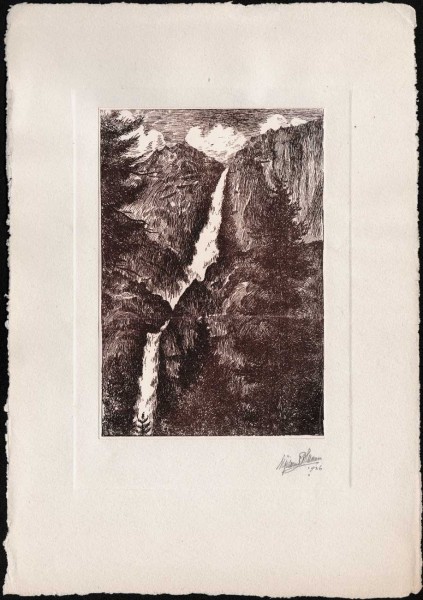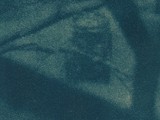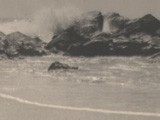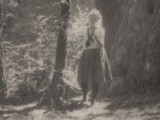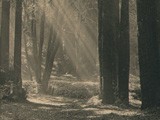Yosemite Falls | Yosemite Valley
PhotographerSigismund Blumann
CountryUnited States
MediumDry Point Etching
Year1926
View Additional Information & Tags
California, Etching, Landscape, Landscape, Forest, Supports, Waterways
Dimensions
Image Dimensions: 13.1 x 9.0 cm glued
Support Dimensions: 23.7 x 16.5 cm deckle-edged, hand-made paper
Associated Blog Posts:
A specialist in alternative darkroom processes, particularly Kallitype and Bromoil, Sigismund Blumann perfected his “Dry Point Etching” process and described it in lengthy articles in Camera Craft in 1925 and later in July, 1934 for his own Photo Art monthly using the pen name “Charles H. Fitzpatrick.”
This finished etching showing the Yosemite Falls and Valley in California’s Yosemite National Park was originally taken as a photograph by Blumann in the Spring of 1925. Both photo and etching were illustrated side-by-side as halftones in the October, 1925 Camera Craft article titled Making Photographs Into Dry Point Etchings. Reminiscent of an actual ink on paper intaglio etching, this example of a “Dry Point Etching” easily fools the eye, and is likely a Kallitype or bleached and toned print on Vitava E (tching) chlorobromide paper based on the process outlined below.
Dry Point Etchings
A printed photograph with little detail is first selected, and the next step is to:
“draw as much as he can on the photograph, using Higgins’ Water Proof India Ink. When this is absolutely dry the silver is completely bleached out with Bichloride of Mercury or Iodine-Iodide bleachers. The pen shading and finishing is then done with care, when the bleached and washed print has been dried.”
From here, a copy negative must then be made which is used to make the final second-generation finished (and reduced for effect) “etchings” using various grades of photographic paper:
“The method of reproducing drawings is very simple. Place drawing on wall or easel and camera on firm support exactly centering lens on drawing, making exposure on a slow copy plate by diffused daylight or electric light, and develop for contrast. In copying it is advisable to reduce the image one-third smaller than the original as a finer line is thus secured which improves the finished print. The writer prefers a buff stock, matt paper of medium grade and heavy; and has found Vitava E just right: This is a matter of choice, however, as good prints may be secured on Azo, Velox, Cyco, Kruxo, Defender, Haloid, Barston, Charcoal Black or other matt papers. Proceed as in ordinary photographic printing then tone by re-development, using whatever process you prefer. I use Royal-Re-developer with pleasing results.”
In the later 1934 Photo Art monthly article: “Etchings From and With Photographs”, “Fitzpatrick”goes further in depth on this etching process, adding that after the second-generation reduced copy print is made, the print could be:
“treated through all the usual solutions in the usual way and may be developed in any of the prescribed formulae for blue-black, jet-black, warm-black, or dark brown tones. Or it may be subsequently toned by the bleach and redevelop methods. The particular brown of an etching is easily gotten on Vitava Athena with a developer containing Athenon, Azo P-2 or 3, Vitava Athena E, Novira in the matt smooth or rough are all fine for the purpose. Gevalux gives a wonderful image in a true carbon black color and velvet crayon patine.”
Continuing, the article offers a summary of the entire process:
“That is all there is to the whole thing. You could not complicate it if you tried. Just make an enlargement, work on it with pen and ink, bleach out the silver leaving the ink image, photograph the line drawing, make as many etching-prints from the copy negative as you wish. Where can you go wrong? How can you fail?”
He concludes by saying the maker of these etchings could also go “one step further by using hand-sensitized photographic papers” for this final second-generation completed “etching”:
“Furthermore, should you desire to print on colored papers or card-board of such surface as cannot be bought ready sensitized it will be a simple matter to sensitize any stock with the well known Blue Print solutions, or if the various shades of brown and black are wanted to resort to Kallitype. These processes are as cheap as they are easy to compound and use; they work on any paper not too saturated with chlorides or unfixed dyes. Kallitype is moreover a beautiful process in itself and prints endure according to the care in making them.”
print notes recto: signed in graphite within lower right corner of impressed primary window mount:
Sigismund Blumann 1926
Provenance: Sigismund Blumann’s grandson.
